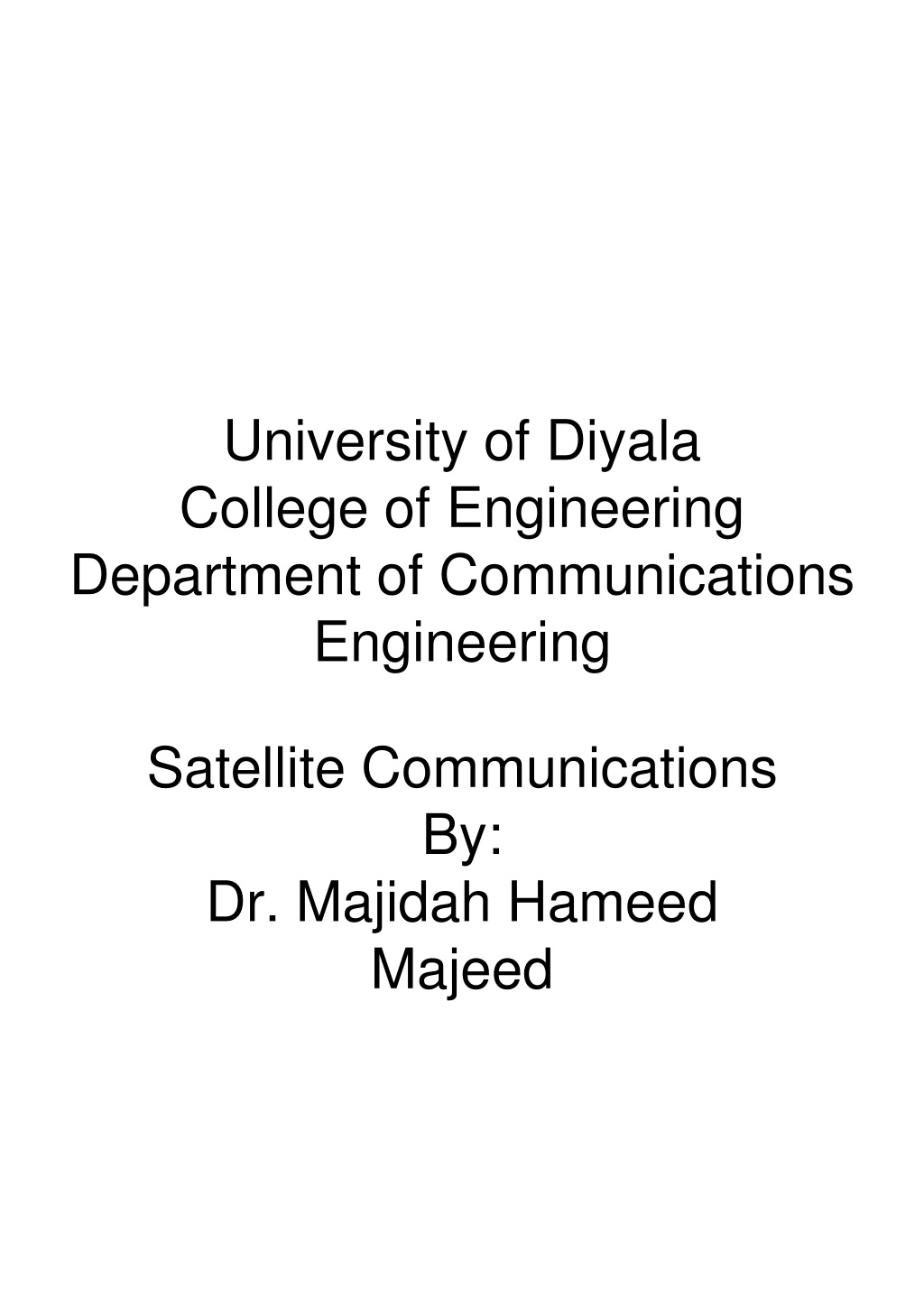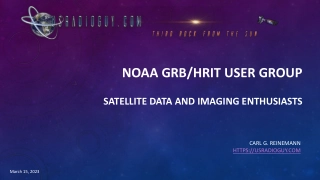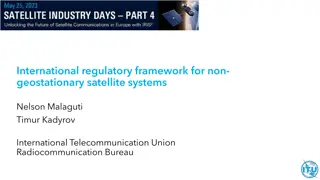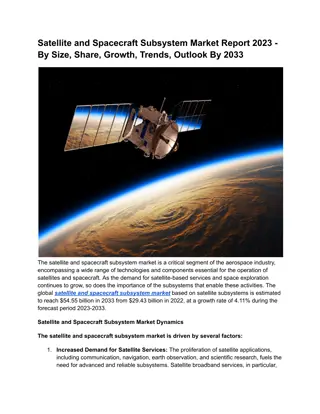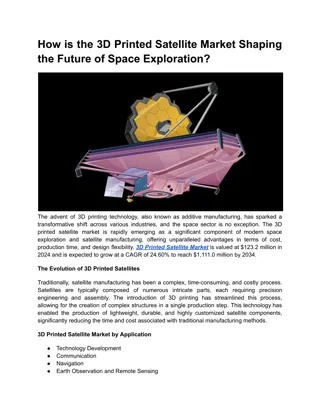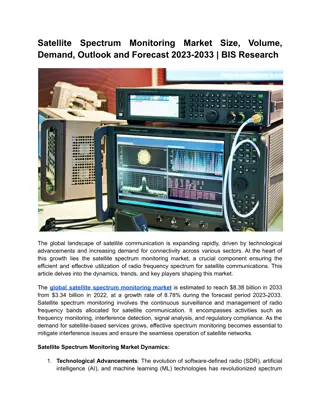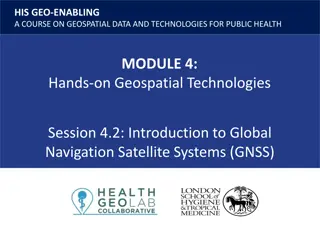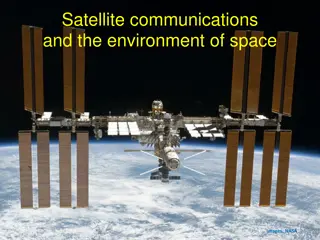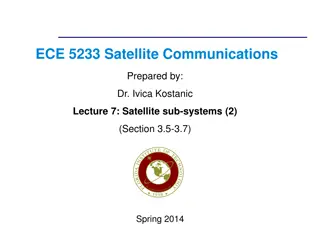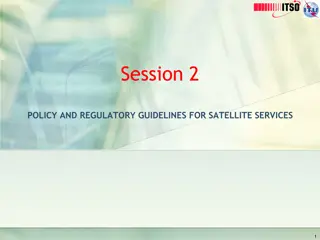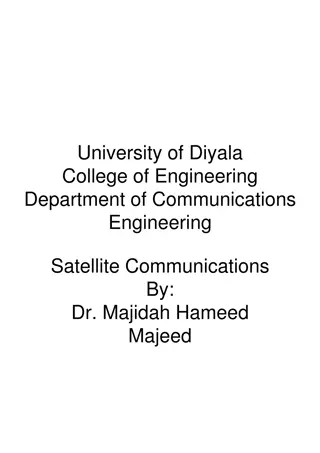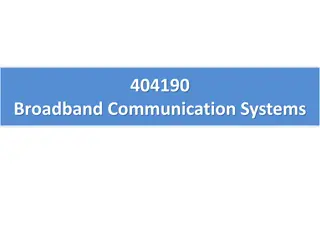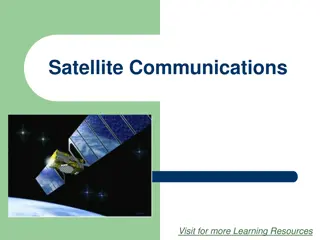Principles of Satellite Communications in Engineering
Explore the history and fundamentals of satellite communications, including the evolution from the first artificial satellite, Sputnik, to modern active and passive satellite systems. Learn about communication via satellites as microwave repeater stations, bridging distances and optimizing frequencies for efficient information exchange. Discover the key role of communication satellites in enabling line-of-sight radio communication and overcoming topographical limitations.
Download Presentation

Please find below an Image/Link to download the presentation.
The content on the website is provided AS IS for your information and personal use only. It may not be sold, licensed, or shared on other websites without obtaining consent from the author. Download presentation by click this link. If you encounter any issues during the download, it is possible that the publisher has removed the file from their server.
E N D
Presentation Transcript
University of Diyala College of Engineering Department of Communications Engineering Satellite Communications By: Dr. Majidah Hameed Majeed
Chapter One PRINCIPLE OF SATELLITE COMMUNICATION 1. History of satellite communications The first artificial satellite was placed in orbit by the Russians in 1957. That satellite, called Sputnik, signaled the beginning of an era. The United States, who was behind the Russians, made an all-out effort to catch up, and launched Score in 1958. That was the first satellite with the primary purpose of communications. The first regular satellite communications service was used by the Navy in 1960. Military satellite communications technology was at a low level until 1965. At that time high quality voice transmissions were conducted between a satellite and two earth stations. For the past fifty years, the Navy has used high-frequency (hf) transmissions as the principal method of sending messages. 2. fundamental satellite communications system A satellite communications system uses satellites to relay radio transmissions between earth terminals. The two types of communications satellites you will study are ACTIVE and PASSIVE. A passive satellite only reflects received radio signals back to earth. An active satellite acts as a REPEATER; it amplifies signals received and then retransmits them back to earth. This increases signal strength at the receiving terminal to a higher level than would be available from a passive satellite. A typical operational link involves an active satellite and two or more earth terminals. One station transmits to the satellite on a frequency called the UP-LINK frequency. The satellite then amplifies the signal, converts it to the DOWN-LINK
frequency, and transmits it back to earth. The signal is next picked up by the receiving terminal. Figure 1-1 shows a satellite handling several combinations of links simultaneously. Figure 1-1. - Satellite communications system.
1.3 Communications via satellite A communication satellite is a microwave repeater station that permits two or more users with appropriate earth stations to deliver or exchange information in various forms. Radio waves, suitable as carriers of information with a large bandwidth, are found in frequency ranges where the electromagnetic waves are propagated through space almost in conformity with the law of optics, so that only line-of sight radio communication is possible. As a result, topographical conditions and the curvature of the earth limit the length of the radio path. Relay stations, or repeaters, must be inserted to allow the bridging of greater distances (see Fig. 1.2). Skyway radar uses the ionosphere, at height of 70 to 300 km, to transmit information beyond the horizon and may not require repeaters. However, transmission suffers from ionosphere distortions and fading. To ensure that appropriate frequencies are optimally selected, additional monitoring equipment is required to sample the ionosphere conditions instantaneously. A communication satellite in orbit around the earth exceeds the latter requirement. Depending on the orbit s diameter, satellites can span large distances almost half the earth s circumference. However, a communication link between two subsystems for instance, earth stations or terminals via the satellite may be considered a special case of radio relay, as shown in Fig.1. 3, with a number of favorable characteristics . Figure 1.2 Intercontinental communication paths.
Figure 1. 3 Communication between two earth stations via a satellite. The investment for a link in the illumination zone is independent of the distance between the terminals. A provision for wide-area coverage for remote or inaccessible territories or for new services is made. This is ideally suited to medium, point-to-multiunit (broadcast) operations. A practical satellite comprises several individual chains of equipment called a transponder: a term derived from transmitter and responder. Transponders can channel the satellite capacity both in frequency and in power. A transponder may be accessed by one or several carriers. Transponders exhibit strong nonlinear characteristics and multicarrier operations, unless properly balanced, which may result in unacceptable interference. The structure and operation of a transponder are addressed in Chapter. 3. 1.3 The characteristics of the satellite orbit The basic design of a satellite communications system depends to a great degree upon the characteristics of the satellite orbit .The satellite can be rotated around the earth through various paths. These paths are called Orbits of the satellite.
These orbits are used to cover the specific application areas. The common types of satellite earth orbits: as shown in fig 1.4 Geostationary Earth Orbits(GEO), Low Earth Orbits(LEO) and Medium Earth Orbits(MEO ). The GEO is a circular orbit in the equatorial plan. The angular velocity of the satellite is the same as that of the earth. Therefore, the satellite seems to be remained stationary in the sky. A special type of orbit is a SYNCHRONOUS ORBIT. In this type you will find the period (time required for one revolution) of the orbit the same as that of the earth. An orbit that is not synchronous is called ASYNCHRONOUS. A period of orbit that approaches that of the earth is called NEAR SYNCHRONOUS (sub synchronous). Orbits are discussed in more detail later in this chapter. We can also classify the orbits of satellites depending on the distance from the surface of the earth as follows: 1- Low Earth Orbit LEO 500 2000 KM 2- Medium Earth Orbit MEO 5000 15000 KM 3- Geostationary Earth Orbit GEO 36000 KM 4- Highly Elliptical Orbit HEO In brief Fig 1.4 satellite orbits
Geostationary Earth Orbit A satellite in a geostationary earth orbit (GEO) revolves around the earth in the plane of the equator once in 24 hours, maintaining precise synchronous with the earth s rotation. There are two other classes of 24 hours orbits: the geosynchronous orbit and the highly elliptical synchronous orbit. Both involve satellites that appear to move relative to a fixed point on the earth. It is well known that a system of three satellites in GEO each separated by 120 of longitude, as shown in Fig. 1.1, can receive and send radio signals over almost all the inhabited portion of the globe (the small regions around the North and south poles-above 81 NL and below 81 SL- are not covered. A given GEO satellite has a coverage region, illustrated by the shaded oval, within which earth stations can communicate with and be linked by the satellite. The range from user to satellite is a minimum 36000 km which makes the design of the microwave link quite stringent in terms of providing adequate received power. Also, that distance introduces a propagation delay of about one-quarter of a second for a single hop between a pair of users. The GEO is the ideal case of the entire class of geosynchronous (or synchronous) orbits, which all have a 24-hour period of revolution but are typically inclined with respect to the equator and/or elliptical in shape.As viewed from the Earth, a synchronous satellite in an inclined orbit appears to drift during a day above and below its normal position in the sky. While ideal, the circular GEO is not a stable arrangement, and inclination naturally increases in time inclination is controlled by the use of an onboard propulsion system with enough fuel for corrections during the entire lifetime of the satellite. A synchronous satellite not intended for GEO operation can be launched with considerably less auxiliary fuel for that purpose. Orbit inclination of greater than 0.1 degree usually is not acceptable for commercial service unless the Earth station antennas can automatically repoint toward (track) the satellite as it appears to move. Mechanical
tracking is the most practical (and cumbersome) approach, but electrical beam steering systems are available for specialized applications such as aeronautical mobile. Orbits that are below a mean altitude of about 36,000 km have periods of revolution shorter than 24 hours and hence are termed non-GEO.As illustrated Figure 1.1 Asystem of three geostationary communication satellites provides nearly worldwide coverage. Orbits that are below a mean altitude of about 36,000 km have periods of revolution shorter than 24 hours and hence are termed non-GEO. As illustrated in Figure 1.2, the Iridium system uses multiple satellites to provide continuous coverage of a given region of the Earth. That is simply because the satellites appear to move past a point on the Earth. The Iridium mobile satellite system employs low Earth orbit (LEO), in which satellites are at an altitude of approximately 780 km and each passes a given user in only a few minutes. In providing telephone services, users are relatively motionless compared to the satellite they are using. Hence, there is a need to hand off a telephone call while it is in progress. The advantage to using a non-GEO satellite network is that the range to the user is shorter; hence, less radiated power is required and the propagation delay is reduced
as well. There is considerable complexity and delay in the processing of telephone calls and data communications due to satellite motion and handoffs. The key dimension of a GEO satellite is its ability to provide coverage of an entire hemisphere at one time.As shown in Figure 1.3, a large contiguous land area (i.e., a country) as well as offshore locations can simultaneously access a single satellite. If the satellite has a specially designed communications beam focused on those areas, then any receiving antennas within the footprint of the beam (the area of coverage) receives precisely the same transmission. Locations well outside the footprint generally are not able to use the satellite effectively. Figure 1.2 The non-GEO satellite constellation used by the Iridium system. Figure 1.3 Typical footprint of a U.S. domestic communication satellite showing coverage of continental and offshore points. Infrastructure. Satellites, on the other hand, are designed to last
only about 15 years in orbit, because of the practical inability to service a satellite in GEO and replenish consumables (fuel, battery cells, and degraded or failed components). Non-GEO satellites at altitudes below about 1,500 km are subject to atmospheric drag and a harsh radiation environment and are likely to require replacement after 10 years of operation. Using the satellite in a duplex mode (i.e., allowing simultaneous two-way interactive communications), a user can employ Earth stations at each end, eliminating any connection with the terrestrial network. In a terrestrial microwave system, radio repeaters must be positioned at intermediate points along the route to maintain line-of-sight contact. It takes about 20 repeater sites to complete a microwave link of 1,000 km. That is because microwave energy, including that on terrestrial and satellite radio links, travels in a straight line with a minimum of bending over or around obstacles. Types ofAsatellite Orbits Satellite Orbits Type of Orbit Circular Elliptical Plane of Orbit Equatorial Polar Inclined Altitude of the orbit Geostationary Satellites (GEO) Low Earth Orbit (LEO) Medium Earth Orbit (MEO)
4. Orbit Descriptions Orbits generally are described according to the physical shape of the orbit and the angle of inclinationof the plane of the orbit. a. Physical Shape All satellites orbit the earth in elliptical orbits. (Acircle is a special case of an ellipse.) The shape of the orbit is determined by the initial launch parameters and the later deployment techniques used. PERIGEE and APOGEE are two, of the three parameters used to describe orbital data of a satellite. These are shown on figure 1-5. Perigee is the point in the orbit nearest to the center of the earth. Apogee is the point in the orbit the greatest distance from the center of the earth. Both distances are expressed in nautical miles. Figure 1-5. - Elliptical satellite orbit. b. Angle of Inclination The ANGLE OF INCLINATION (angle between the equatorial plane of the earth and the orbital plane of the satellite) is the third parameter used to describe the orbit data of a satellite. Figure 1-6 depicts the angle of inclination between the equatorial plane and the orbital plane. Most satellites orbit the earth in orbital planes that do not coincide with the equatorial plane of the earth. A satellite
orbiting in any plane not identical with the equatorial plane is in an INCLINED ORBIT. Figure 1-6. - Inclined satellite orbit. The inclination of the orbit determines the area covered by the path of the satellite. As shown in figure 1-7, the greater the inclination, the greater the amount of surface area covered by the satellite. Figure 1-7. - Effect of orbit plane inclination on satellite coverage.
